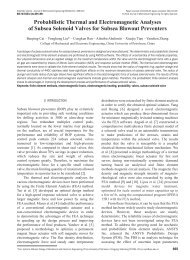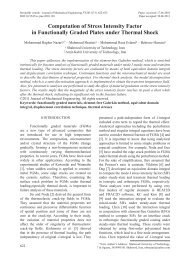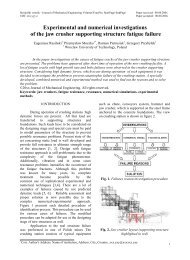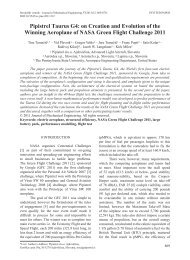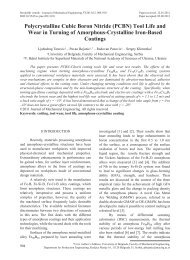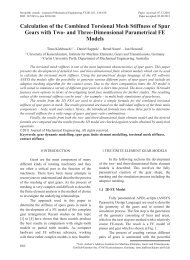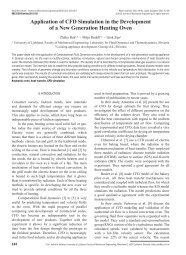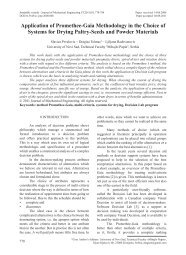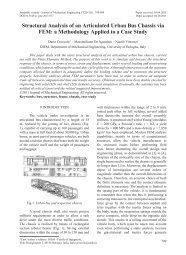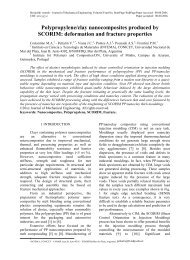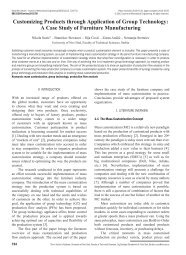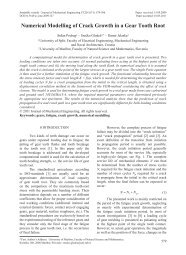Simulation of Water-Gas Shift Membrane Reactor for Integrated ...
Simulation of Water-Gas Shift Membrane Reactor for Integrated ...
Simulation of Water-Gas Shift Membrane Reactor for Integrated ...
- No tags were found...
Create successful ePaper yourself
Turn your PDF publications into a flip-book with our unique Google optimized e-Paper software.
Strojniški vestnik - Journal <strong>of</strong> Mechanical Engineering 57(2011)12, 911-926rate and the permeation through the membrane.The calculated data were then imported in AspenPlus as input (or initial) values <strong>for</strong> simulations.Aspen Plus was used to predict thebehaviour <strong>of</strong> a WGSMR by using basic engineeringrelationships, such as mass and energy balances,and phase and chemical equilibrium. According tothe calculated data from Mathematica, predictedoperating conditions, and different design models,the behaviour <strong>of</strong> MR was simulated.around 1.1 can be reached with quench waterat 260 °C.2.1 Initial and Boundary ConditionsIn IGCC system the MR will be situatedafter the gasifier and be<strong>for</strong>e the gas turbinecombustor, replacing the WGS reactor and PSAsystem (see Fig. 1).The boundaries <strong>for</strong> the modelled systemare marked with the dashed line in Fig. 4. Inthis figure n represents the molar flow, x thecomposition, T the temperature and p the pressure<strong>of</strong> gas stream. Heat duty is represented with Qand CO conversion with X CO . Index GAS stands <strong>for</strong>syngas, R <strong>for</strong> retentate side and P <strong>for</strong> permeate side<strong>of</strong> the membrane.Based on the position in the chain <strong>of</strong>processes that take part in the IGCC, the initialand boundary conditions <strong>for</strong> “base case” studieswere defined:a) Based on gasifier:• The modelling is based on a dry-feedentrained-flow gasifier with water quench.There<strong>for</strong>e, the maximum outlet pressure fromthe gasifier is presumed to be around 50 bar.• The outlet temperature from the gasifier is setto 1500 °C.• Composition <strong>of</strong> syngas has a major role indefining the steam-to-CO ratio and especiallyin defining the H 2 partial pressure.b) Based on quench:• The quench temperature is set to 800 °C. Inorder to reach this temperature the syngas hasto be quenched with water and not steam.• With pressure <strong>of</strong> 50 bar, equal to syngas,quench water can only reach temperaturesup to 264 °C, otherwise it would begin tovaporise.• Steam-to-CO ratio is also dependent on thetemperature <strong>of</strong> quench water. Maximum ratioFig. 5. Schematic presentation <strong>of</strong> the reactormodelc) Based on MR:• For modelling the tubular MR with gaugemeasurements L = 40 m and a = 10 m wasselected (see Fig. 5). The outer tubularmembrane diameter was set to the value 2r =7.5 cm.• The operational temperature range <strong>of</strong> the MRis presumed to be between 700 and 900 °C.• The pressure on the retentate side is definedby the outlet from the gasifier. In this study itis presumed to be 50 bar.• Low pressure on the permeate side increasesthe driving <strong>for</strong>ce through the membrane.However, from the point <strong>of</strong> energy lossneeded <strong>for</strong> compression the minimumpressure should not be less than 1 bar.• In order to improve the driving <strong>for</strong>ce the N 2sweep gas is introduced. In view <strong>of</strong> syngasthe flow <strong>of</strong> N 2 is in counter-current directionwhere H 2 -to-N 2 molar ratio at the exit is 1:1.• Since the WGSR is an exothermal reaction,the reactor is water cooled. In the presentstudy the MR will operate at isothermalconditions.• The desired CO conversion is set to be around95%.• Based on the temperature range, pressureconditions, hydrogen purity and permeability,the selected membrane material isPalladium based with permeance:k′ = 3·10 -4 mol m -2 s -1 Pa -0.5 .916 Lotrič, A. ‒ Sekavčnik, M. ‒ Kunze, C. ‒ Splieth<strong>of</strong>f, H.



